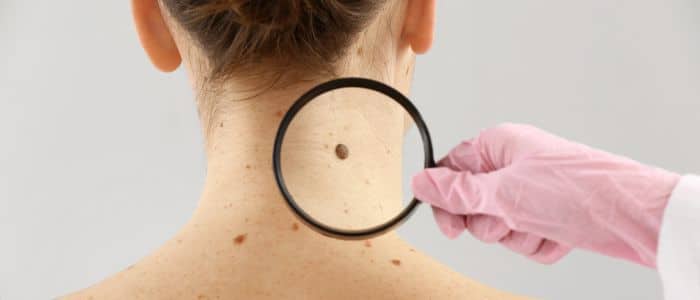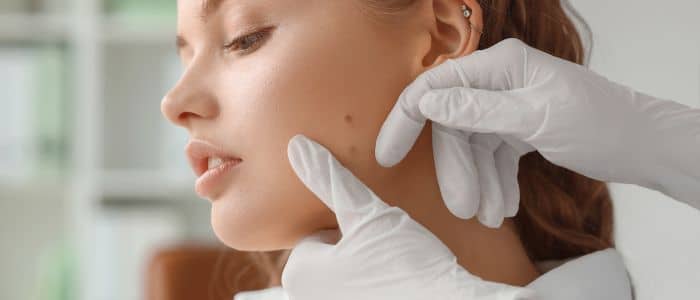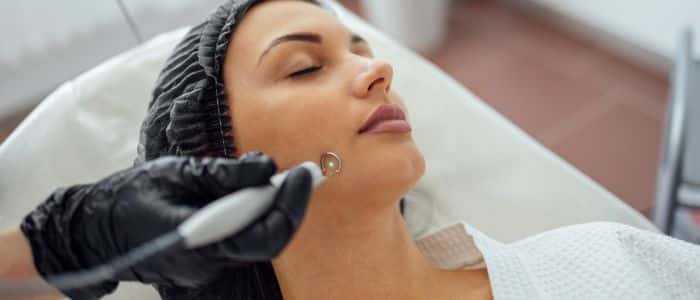
- A Guide to Safe and Effective Mole Removal Options
- Take our Plastic Surgery Quiz to find out if you'd be a good candidate for cosmetic surgery.
- The ABCs of Moles
- Consulting a Professional for Mole Removal
- Types of Surgical Mole Removal Methods
- Excision with Stitches
- Shave Excision
- Laser Mole Removal
- Risks and Complications
- FAQs about How to Get Rid of Moles
- Can I remove a mole myself at home?
- How can I tell if a mole needs to be removed?
- What is the average healing time after mole removal?
- Will mole removal leave a scar?
- Further Reading about Skin Surgery with Consultant Plastic Surgeon Anca Breahna
- Medical References about How to Get Rid of Moles
A Guide to Safe and Effective Mole Removal Options
Moles are common skin growths that most people have. While they are usually harmless, there are instances where you might consider having them removed. Surgical solutions for mole removal have advanced significantly, offering safe and effective ways to remove moles that cause discomfort or concern. Whether due to medical advice or personal preference, the decision to remove a mole is significant. It is essential to approach this with a clear understanding of the options available. Surgical removal methods vary, each with its own set of procedures and recovery processes. Chester Consultant Plastic Surgeon Anca Breahna can offer personalised advice based on the characteristics of your mole and your skin type. This initial step is important in ensuring the safety and success of the removal process. Moreover, understanding the aftercare and recovery is key to achieving the best possible outcome.
Take our Plastic Surgery Quiz to find out if you’d be a good candidate for cosmetic surgery.
The ABCs of Moles
Moles, known medically as nevi, are small, coloured spots on the skin that are a common occurrence. They are formed by clusters of pigmented cells called melanocytes and can appear anywhere on the body. Moles vary in colour, shape, and size, typically emerging during childhood and adolescence. While most moles are harmless and require no treatment, changes in their appearance can sometimes signal health issues.
The significance of understanding moles lies in distinguishing between benign growths and those that warrant medical attention. It’s essential to monitor moles for any changes in size, shape, colour, or texture, as well as the appearance of new symptoms such as bleeding, itching, or pain.
In terms of reasons for removal, moles are usually removed for two main reasons: medical concerns or personal preference. From a medical perspective, moles that present a risk of melanoma or other skin cancers are usually recommended for removal. On the other hand, some individuals choose to remove moles that they find bothersome or unattractive, especially if located in visible areas such as the face or neck.
Consulting a Professional for Mole Removal
Making the decision to remove a mole, whether for medical or personal reasons, necessitates consulting your surgeon. Anca is specialised in treating skin conditions, including mole assessments and removals. This step is indispensable as it ensures the mole is evaluated professionally to determine the most appropriate removal method.
The initial consultation involves a thorough examination of the mole in question, as well as a discussion about your medical history and any changes you’ve noticed in the mole. It’s important to prepare for your appointment by making a list of any questions or concerns you might have, as well as noting any significant changes in the mole’s appearance or any new symptoms. Being prepared will help you make the most of your consultation.
During the visit, Anca may use a dermatoscope, a special magnifying tool, to get a closer look at the mole. This examination helps Anca assess whether the mole shows signs of being cancerous and decide on the necessity and method of removal. If there is a concern about cancer, Anca might recommend a biopsy, where a small piece of the mole is removed and sent to a lab for further examination.
Types of Surgical Mole Removal Methods
When it comes to removing a mole surgically, several methods can be employed, each suited to different types of moles and patient circumstances. Each of these methods has its advantages and potential drawbacks, which Anca will discuss with you. Factors such as the size, depth, and location, as well as your skin type and overall health, will influence the recommended approach.
Excision with Stitches
Excision with stitches is a common surgical method for mole removal, particularly recommended for moles that are large, potentially cancerous, or located in areas where a precise cosmetic outcome is desired. This procedure involves cutting out the mole along with a margin of surrounding skin to ensure complete removal and reduce the risk of recurrence.
The process begins with the area being thoroughly cleaned and then numbed using a local anaesthetic. Anca will use a scalpel to cut around and under the mole, removing it entirely. The size of the margin removed depends on the reasons for the its removal; for example, a larger margin may be taken if there’s concern about cancer. Once the it is removed, the wound is closed with stitches. These may be dissolvable stitches under the skin, which do not require removal, or non-dissolvable stitches on the surface, which will need to be taken out after a certain period, usually within one to two weeks.
Recovery after an excision with stitches varies depending on the size and location of the mole removed. It’s normal to experience some discomfort, swelling, and redness around the site. Anca will provide specific aftercare instructions, which may include keeping the area clean and dry, applying antibiotic ointment, and avoiding strenuous activities that could strain the area.
The scar’s appearance will gradually improve over time, but it’s important to follow Anca’s advice on scar care to achieve the best possible outcome. This might include using silicone sheets or gels and applying sunscreen to prevent darkening of the scar.
Sending the removed mole for laboratory analysis is a standard part of this procedure, offering peace of mind by confirming that all cells are benign. In cases where cancerous cells are detected, further treatment may be necessary.
Shave Excision
Shave excision is a surgical technique commonly used for removing moles that protrude above the skin surface. It’s particularly suited for moles that are benign and do not necessitate a deep surgical removal. This method is favoured for its simplicity, minimal discomfort, and the reduced likelihood of leaving a significant scar.
The procedure starts with Anca cleaning the area around the mole. Local anaesthetic is then applied to numb the site, ensuring comfort throughout the process. Using a sharp, small blade, the dermatologist shaves the mole off flush with the surrounding skin or slightly below it. Because the mole is removed at or just beneath the skin level, stitches are generally not required, simplifying the healing process.
Shave excision has several benefits, including a shorter procedure time, immediate improvement in the area’s appearance, and minimal aftercare. The risk of scarring is significantly lower than with more invasive methods, making it a popular choice for moles on highly visible areas, such as the face.
After the procedure, the treated area may be covered with a small dressing or left open, depending on Anca preference and the wound’s size. You are advised to keep the area clean and dry, and may be prescribed an antibiotic ointment to prevent infection. Mild soreness and swelling can occur but typically subside within a few days.
Laser Mole Removal
Laser mole removal is a modern, non-invasive method that uses targeted laser light to diminish or eliminate moles, particularly effective for small, dark, and flat moles. This technique is preferred for its precision and the minimal damage to surrounding skin, making it an excellent option for facial moles or areas where a traditional scar would be undesirable.
The procedure begins with a consultation to assess the suitability of your mole for laser removal. Not all moles are appropriate candidates; laser removal is best for moles that are superficial and have been assessed as benign. The treatment area is cleaned, and a local anaesthetic may be applied to ensure comfort. The laser device is then used to emit short bursts of light that specifically target the melanin (pigment) within the mole. This process breaks down the pigment, which the body gradually absorbs, causing it to fade over several sessions.
Laser mole removal has several advantages, including reduced risk of scarring, no need for stitches, and a quicker recovery time compared to surgical methods. Patients typically experience minimal discomfort during the procedure, often described as a sensation similar to the snap of a rubber band against the skin. Post-treatment, you may notice redness and swelling in the treated area, which generally subsides within a few days.
Aftercare involves keeping the area clean and protected from the sun, as UV exposure can affect the healing process and pigment changes. It’s also essential to follow any specific aftercare instructions provided by Anca to ensure optimal healing and results.
While laser mole removal is effective, it may require multiple sessions to achieve the desired outcome, especially for darker or larger moles. Additionally, there is a slight chance that the mole may not be completely removed or could recur, necessitating further treatment.
Risks and Complications
While mole removal surgery is generally safe, as with any surgical procedure, there are potential risks and complications. Being aware of these allows you to make an informed decision and take steps to minimise their likelihood. Here are some common risks associated with mole removal:
- Infection: One of the most common risks following any surgical procedure is infection. Signs include increased redness, swelling, warmth, and discharge from the site. Following Anca’s wound care instructions and using any prescribed antibiotic ointments can significantly reduce this risk.
- Scarring: All forms of mole removal carry a risk of scarring. The extent of scarring depends on the mole removal method, the site’s location, and your skin type. Anca will take steps to minimise scarring, and following aftercare instructions on wound care and sun protection can help improve the scar’s appearance over time.
- Pain: Some discomfort is expected after mole removal, particularly once the local anaesthetic wears off. This is usually manageable with over-the-counter pain relief. However, persistent or worsening pain may indicate complications and should be assessed by Anca.
- Allergic Reactions: On rare occasions, patients may have allergic reactions to the anaesthetic or other medications used during or after the procedure. Inform Anca of any known allergies ahead of the procedure to mitigate this risk.
- Changes in Skin Sensation: The area around the removal site may experience temporary numbness, tingling, or a loss of sensation. These symptoms typically improve as the area heals, but it’s important to report any lasting changes to Anca.
- Pigmentation Changes: The skin where the mole was removed may become lighter or darker than the surrounding area. Sun protection is important to prevent darkening of the scar.
- Mole Recurrence: Especially with shave excision, there’s a possibility that the mole may regrow if any cells remain in the skin. Monitoring the area and regular check-ups can help address recurrence early.
FAQs about How to Get Rid of Moles
Can I remove a mole myself at home?
- It’s strongly advised against attempting to remove a mole by yourself at home. DIY methods can lead to infections, scarring, and potentially interfere with the diagnosis of any underlying conditions, including skin cancer.
How can I tell if a mole needs to be removed?
- A mole should be evaluated by a doctor if it changes in size, shape, colour, or texture, or if it starts to bleed, itch, or become painful. These changes can sometimes indicate skin cancer. A professional evaluation can determine whether removal is necessary for health reasons or if it’s safe to leave the mole as is.
What is the average healing time after mole removal?
- The healing time varies depending on the mole removal method. Shave excisions and laser treatments usually heal within 1 to 2 weeks, while excisions with stitches might take 2 to 4 weeks to heal completely. Anca will provide a more precise recovery timeline based on your specific case.
Will mole removal leave a scar?
- All surgical procedures have the potential to leave a scar, but the size and visibility of the scar depend on the mole’s size, the removal method, and how well you follow aftercare instructions.
Further Reading about Skin Surgery with Consultant Plastic Surgeon Anca Breahna
- Read more about Recovery after Mole Removal
- Read more about Recovery after Cyst Removal
- Read more about Recovery after Skin Tag Removal
- Read more about Recovery after Lipoma Removal
- Read more about The Mole Guide
- Read more about How to Get Rid of Old Scars
- Read more about Treatment Options for Lipoma and Other Swellings
Medical References about How to Get Rid of Moles
- Removal of Moles – NCBI
- Can home remedies get rid of moles? 14 ways – Medical News Today
- Moles – Diagnosis and treatment – Mayo Clinic
- Mole Removal: Surgery, Aftercare & Scars – Cleveland Clinic
- Moles: Types, causes, treatment, and diagnosis – Medical News Today



 Ms Anca Breahna, PhD, MSc, FEBOPRAS, FRCS (Plast) is a highly regarded Consultant Plastic Surgeon specialising in the field of Aesthetic and Reconstructive Plastic Surgery. Anca performs a range of
Ms Anca Breahna, PhD, MSc, FEBOPRAS, FRCS (Plast) is a highly regarded Consultant Plastic Surgeon specialising in the field of Aesthetic and Reconstructive Plastic Surgery. Anca performs a range of 